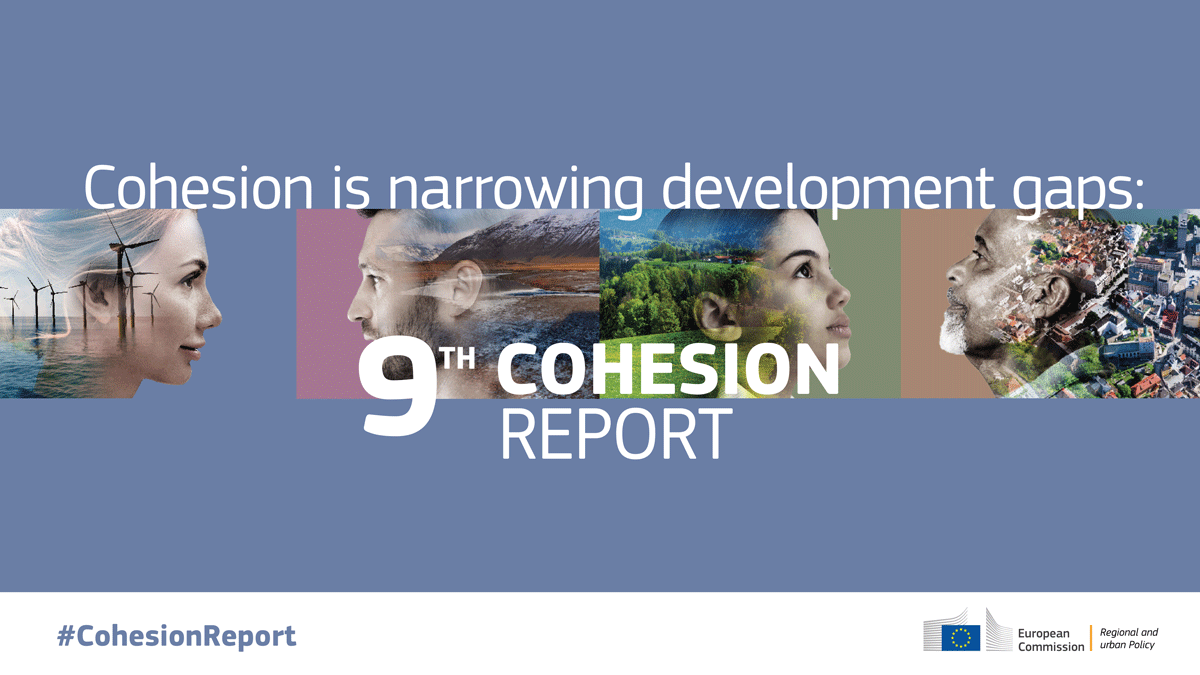Cohesion policy is narrowing development gaps: 9th Cohesion Report
- 27 Mar 2024

The report, a recurrent assessment of the state of cohesion in the EU, the last of which appeared in 2022, provides a picture of what has been achieved and what still needs to be done to guide EU policies aimed at ensuring balanced, long-term growth. It assesses whether disparities have narrowed, which regions are leading, and which still need to catch up.
European Commissioner for cohesion and Reforms, Elisa Ferreira commented: ‘The 9th cohesion Report shows that, over the last 20 years, cohesion policy has succeeded in its mission to promote economic, social and territorial cohesion among regions. For citizens of Member States from the 2004 enlargement, cohesion policy has meant new opportunities, new prosperity and a better quality of life.’
Cohesion policy works
Over 30 years after the launch of the European single market and 20 years on from the 2004 enlargement, the report shows that removing barriers to free movement has improved resource allocation and fostered exchange of ideas and innovation across Europe. The diversity of its regions offers the EU numerous competitive advantages.
Cohesion policy investments in infrastructure, innovation and education have enabled regions to reap the benefits of international competition. By boosting the effectiveness of the single market, these investments have helped to develop strong intra-EU value chains, notably in critical technologies. This has reinforced regional resilience in the face of crises and the EU’s strategic autonomy in a difficult geopolitical context.
EU regions have achieved remarkable convergence, largely thanks to cohesion policy. In the Member States that joined since 2004, GDP per capita increased from 52 % of the EU average in 2002, while unemployment fell from 13 % to 4 %.
Cohesion policy investments in the 2014-2020 and 2021-2027 programmes are expected to increase EU GDP by 0.9 % by 2030. The programmes have long lasting effects and 30 years after their start, each euro invested will have generated three additional euros of GDP. Their impact is much bigger in central and eastern Europe: for example, one of the latest countries to join the EU such as Croatia is projected to experience an 8% GDP increase. Growth in less-developed regions, the main beneficiaries of the policy, also benefits more-developed regions by stimulating demand for their goods and services, in the short run directly because of the investments funded by the policy and in the long run because the increased imports from less-developed regions.
Furthermore, cohesion policy resources were mobilised rapidly to alleviate the impact of the COVID-19 pandemic, bolstering the EU’s capacity to withstand shocks and preventing the emergence of new disparities. In a first step, the Coronavirus Response Investment Initiative (CRII) devoted € 23 billion of Cohesion Funds to fight the pandemic. Later, the Recovery assistance for cohesion and the territories of Europe (REACT-EU) delivered thought Cohesion Funds EUR 50.6 billion of additional support.
Persistent challenges
Nonetheless, challenges remain. As Commissioner Ferreira explained: ‘Cohesion policy is confronted with challenges ranging from regions in a development trap, internal disparities in regions and brain drain from less-developed to more-developed regions.’
Convergence between Member States is sometimes accompanied by widening disparities within countries, particularly between capital and non-capital regions. At the same time, certain regions are stagnating, leading to political discontent.
Other regions – some facing deep-seated structural problems – persistently lag behind, despite substantial support. Here, cohesion policy remains a source of stability, ensuring access to basic services. Without it, the situation could deteriorate dramatically.
In addition, despite simplification of the legislative framework, some regions in most need of support struggle to make full use of their allocated resources.
Cohesion policy is more relevant than ever
The report highlights persistent disparities, which, if not addressed, may be exacerbated by the green and digital transitions, demographic decline and an uncertain geopolitical situation.
Cohesion policy is needed more than ever to keep the EU united. The alternative would be a fragmented EU with a malfunctioning single market, incapable of providing stability for its citizens. This would fuel tensions, undermining the European project and future enlargements.
Cohesion policy cannot address these issues alone, but it will play a vital part, both by building on previous achievements, through partnerships with less-developed regions, and by modernising.
‘We need to modernise the policy. We need a more simplified legal framework, a faster implementation, enhanced linkage with reforms and built-in flexibilities for unforeseen crises. This will ensure cohesion policy’s role as the glue that holds Europe together,’ said Commissioner Ferreira.
Further simplification of the programming framework will allow less developed and vulnerable regions to benefit, without prejudice to EU financial interests. To accelerate implementation, the policy could draw on the experience of other EU instruments in areas such as decoupling of payments from expenditure. Better links with reforms would overcome obstacles to growth by tailoring support to regional situations.
Future enlargement
Finally, future enlargements make a clear case for cohesion policy. Newcomers will be poorer, again increasing disparities within the EU. As well as needs, they will have expectations, which the EU will have to meet while addressing challenges in current Member States. Cohesion policy will thus face a battle on two fronts.
But, as Commissioner Ferreira concluded: ‘cohesion policy has proven that it can successfully take up challenges linked to enlargement and is ready to take up challenges linked to a new EU enlargement.’
The report will stimulate discussions at the Cohesion Forum, scheduled for 11-12 April. Public and civil society representatives will debate how the policy can ensure that all regions benefit from the EU’s ongoing structural changes.


